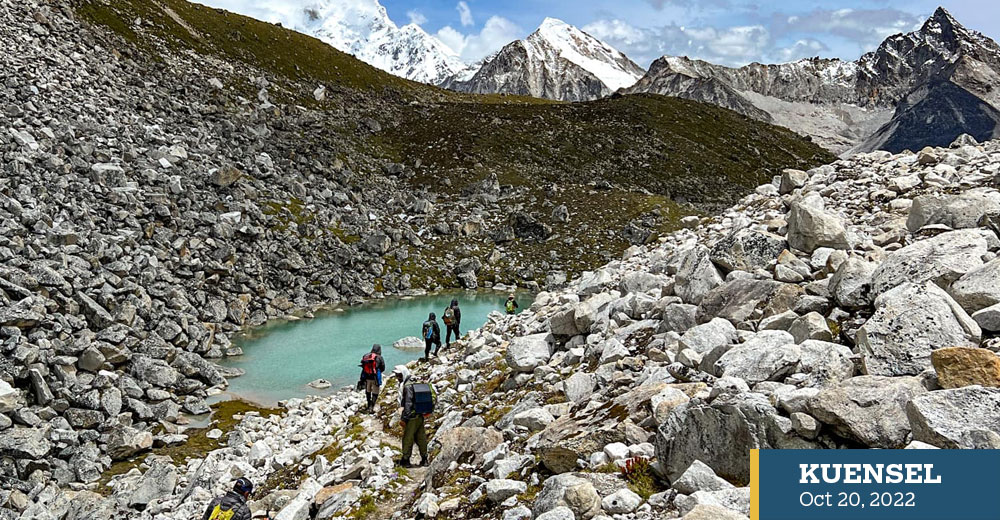The runners call for urgent climate action globally
Thinley Namgay and Choki Wangmo
The recent Snowman Race carried a universal message of climate change. For ultra-marathon runners, it was a transformative journey.
At the first Bhutan Climate Action Conclave on October 18, after the race, the runners reflected on their journeys and their understanding of the impact of climate change in the highland communities.
Sangay Wangchuk, 39, from the Royal Bhutan Army, said he took part in the race to understand the impact of climate change on the highlanders.
Sangay Wangchuk said: “In the 2019 calibration run from Gasa to Bumthang, I saw thick snow in the mountains. In this snowman race, I found that it had decreased a lot. Mosquitos are also found in the mountains. It shows global warming is happening.”
The chief of weather and climate services division with the National Centre for Hydrology and Metereology, Singay Dorji (PhD), said that the impacts of climate change has become more evident in recent years. Extreme weather events, for example.
Karma Yangden, 30, from Laya, said that there is no timely snowfall in Laya today. “In winter, we used to come down to Punakha due to the cold, but we don’t anymore because there is no snow in Laya.”
“Landslides are frequent and we lost a few people last year. In the past, we didn’t get water, as the place used to be covered in ice. Now, it has become easy to find water,” she said.
She said she would share her experience of the snowman race with her communities.
The runners emphasised the need for an urgent call for climate action globally.
Sharing the impacts of climate change back at home in Dagana, Sangay Wangchuk said that Bhutan alone cannot fight global warming. “Due to erratic rainfall patterns, food security is at risk. I hope that international participants will become better advocates.”
Bhutan, he said, should share these concerns properly with the international communities at the COP27.
International participants said that they joined the race to be a better advocate for climate action and to learn from Bhutan’s way of combating climate change.
Along the route, they observed the footprints of glaciers that are receding, the destruction of the Gasa hot spring by the flood, and also understood the threat to the people.
An international participant said: “We will come back to participate in the next Snowman Race. Hospitality is great and people in the highlands welcomed us wholeheartedly,” said one. We must act now. Swift and significant change is needed at the global level.”
“The amount of water that comes from the mountain has affected the people,” said the 50-year-old ultra-runner from Tanzania, Simon Mtuy, adding that Bhutan has good conservation plans in place and has been using the natural resources efficiently.
Of the total of 29 runners—20 foreigners and nine locals—17 completed the 203km race in four days.
Chairperson of the snowman race secretariat, Kesang Wangdi, said that the glacial reserve in Bhutan had shrunk by 22 percent between 1980 and 2010. “Glaciers in the Himalayas are perishing faster than anywhere else.”
He said that the melting of glaciers increases the risks of glacial lake outburst floods which threatens lives downstream as there are 17 potentially dangerous glacial lakes identified in the country.
Kesang Wangdi said that the temperature in the Hindukush Himalayan Region is predicted to increase by one to two-degree celsius by 2050 and changes in precipitation will have a major impact on the availability of water resources affecting agriculture, energy and the economy of the most vulnerable people downstream.
He said that climate change is unfair and inequitable. “Top 10 percent of the world population or the advanced economies contribute about 50 percent of the greenhouse gas emissions. The bottom 10 contribute only 12 percent… Climate action, therefore, undeniably has a moral direction for us to act.”
The video of the negative impact of climate change in the highland communities was also broadcast during the conclave. The video portrays changes in the highland such as less snowfall, rising temperatures, and unusual snowfall patterns.
Participants from 11 countries across the globe took part in the race.


